Driest February in 30 years for England
Author: Press Office
15:57 (UTC) on Wed 1 Mar 2023
England had its driest February in 30 years according to provisional figures from the Met Office, as meteorological winter concluded with a dry and mild month for most.
Rainfall was in short supply in February, with high pressure dominating much of the month and no UK nation reaching its long-term average rainfall for February.
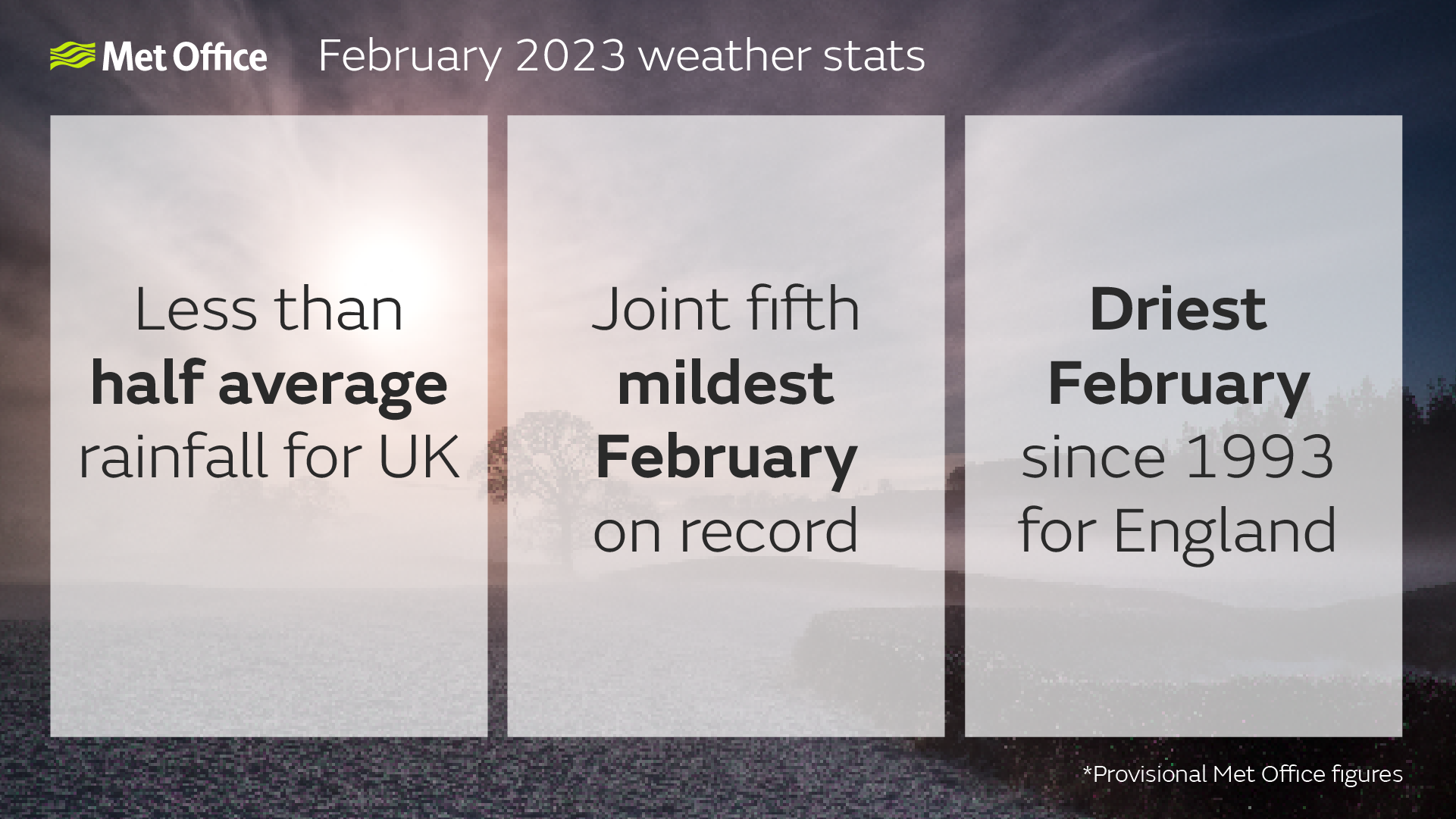
England had its eighth driest February in a series which goes back to 1836, and its driest since 1993, with on average just 15.3mm of rain falling in the month.
Areas to the south and east were particularly dry, with Bedfordshire, Greater London and Essex all recording figures to put the month in their respective top five driest Februarys on record. At a county level, Essex had the least amount of rainfall with 3.5mm falling in the month, just 8% of its average.
That dry theme was replicated across the majority of the UK with Wales and Northern Ireland seeing significantly less rainfall than average. Wales had 26.2mm of rain (22% of average) and Northern Ireland 31.3mm (34% of average). Scotland was still dry, though not to the same extent as further south with 97mm of rain (69% of average).
This means the UK saw less than half of its average rainfall for the month, with 43.4mm falling, just 45% of average.
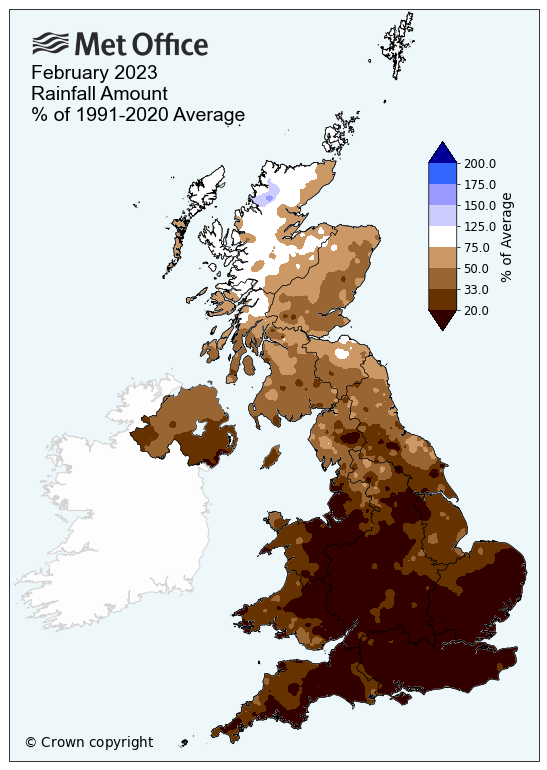
Dr Mark McCarthy of the Met Office’s National Climate Information Centre said: “The second half of January was largely dry and that theme continued through February with high pressure centred over the UK for much of the month, helping to repel advancing fronts and keep low pressure systems away, and resulting in a notable long winter dry spell.
“That high pressure has principally, but not exclusively, been focused around the southern half of the UK, meaning southern England has been particularly dry, with just 9.7mm of rain falling here, which is just 16% of its average.”
Environment Agency Executive Director and National Drought Group chair John Leyland said: “While most water levels have returned to normal across much of the country, low rainfall in recent weeks highlights the importance of remaining vigilant.
“We cannot rely on the weather alone, which is why the Environment Agency, water companies and our partners are taking action to ensure water resources are in the best possible position both for the summer and for future droughts.
“As ever, it is important that we all continue to use water carefully to protect not just our water resources; but our precious environment and the wildlife that depends on it.”
Joint fifth mildest February on record for UK
The dry conditions were accompanied by mild temperatures for the time of year, with the UK having its joint fifth mildest February on record in a series which goes back to 1884.
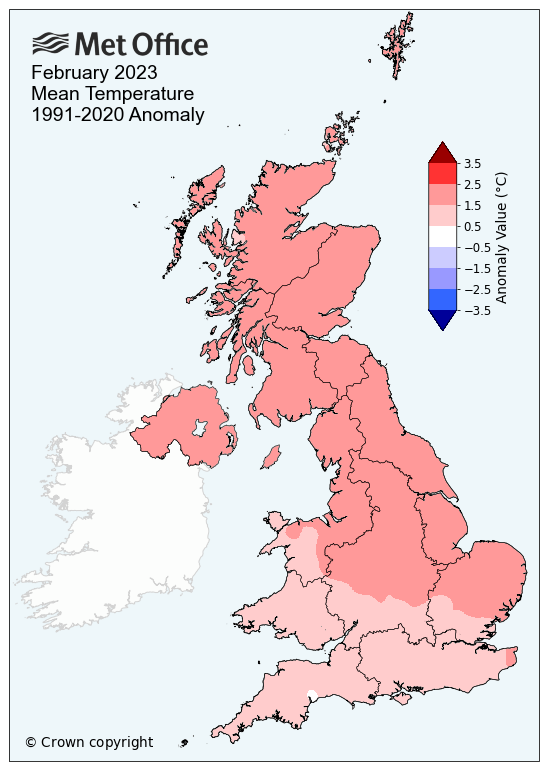
The UK’s average mean temperature for the month was 5.8°C, failing to top the record 6.8°C figure set in 1998.
Scotland had its third mildest February on record, with average mean temperatures of 5.1°C, while Northern Ireland had its fourth mildest, with an average mean temperature of 6.6°C. While England and Wales were milder than average, it wasn’t enough to trouble the top records for the month.
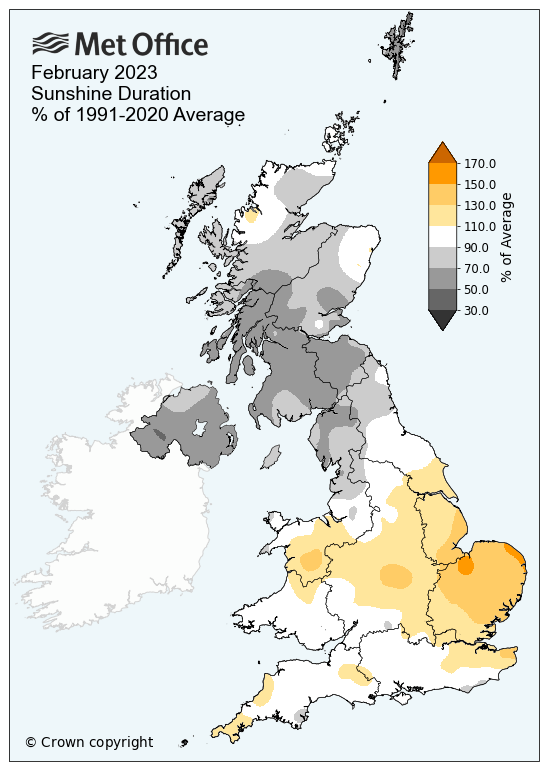
Sunshine was near-average for the UK, though Northern Ireland was much duller than average with 39.1 hours of sunshine in the month, just 58% of its average. However, good levels of sunshine in the south and east means the UK ends the month with 70.2 hours of sunshine, which is 98% of the average.
Provisional February 2023 statistics
| Maximum temp | Minimum temp | Mean temp | Rainfall | Sunshine | ||||||
|---|---|---|---|---|---|---|---|---|---|---|
| Area | Actual temp (°C) | Anomaly (°c) | Actual temp (°C) | Anomaly (°C) | Actual temp (°C) | Anomaly (°C) | Actual (mm) | Anomaly (%) | Actual (hours) | Anomaly (%) |
| UK | 9.0 | 1.9 | 2.6 | 1.5 | 5.8 | 1.7 | 43.4 | 45 | 70.2 | 98 |
| England | 9.7 | 1.9 | 2.7 | 1.2 | 6.2 | 1.5 | 15.3 | 23 | 85.9 | 110 |
| Wales | 8.9 | 1.5 | 2.7 | 1.1 | 5.8 | 1.3 | 26.2 | 22 | 74.2 | 107 |
| Scotland | 7.9 | 2.0 | 2.2 | 1.9 | 5.1 | 2.0 | 97.0 | 69 | 48.4 | 76 |
|
N. Ireland |
9.4 | 1.6 | 3.8 | 2.3 | 6.6 | 2.0 | 31.3 | 34 | 39.1 | 58 |
Sunny winter for most
The sun shone for much of meteorological winter (December, January and February), with the south and east particularly sunny and sunshine figures closer to average for Northern Ireland and Scotland.
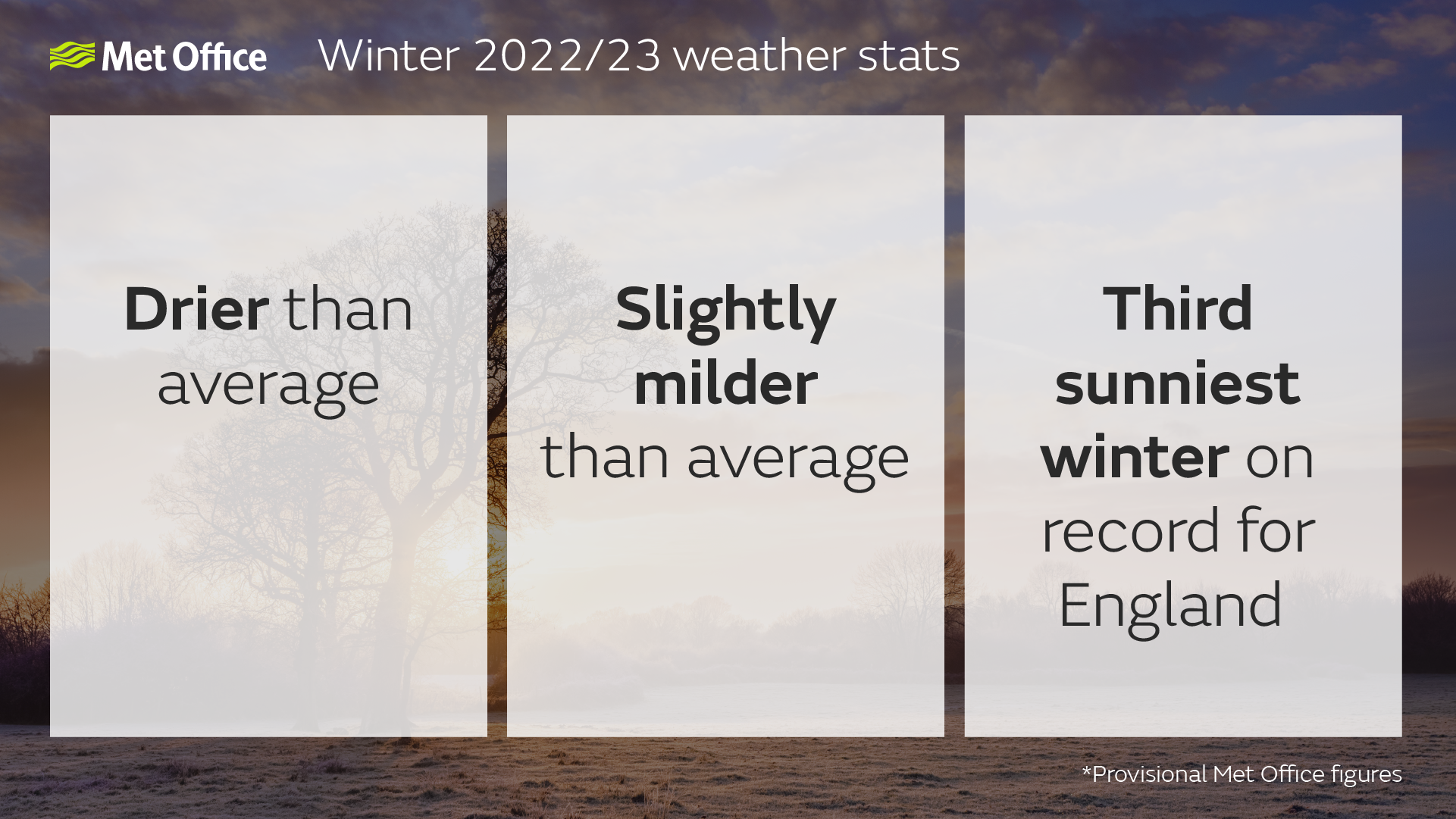
For England, it was the third sunniest winter on record in a series which goes back to 1919, with 223.2 hours of sunshine, which is 21% more than average.
Wales had 180.9 hours of sunshine (15% more than average), while Northern Ireland and Scotland both reported figures nearer to average, though the Western Isles and Shetland had fairly dull months, with at least 25% fewer sunshine hours than average, though not low enough to trouble any records.
The dry February has led to a drier than average season, with figures remarkably close to average at the end of January. The UK had 280.1mm of rain in the winter, which is 81% of the long-term average, though doesn’t make it a significant season in terms of record figures.
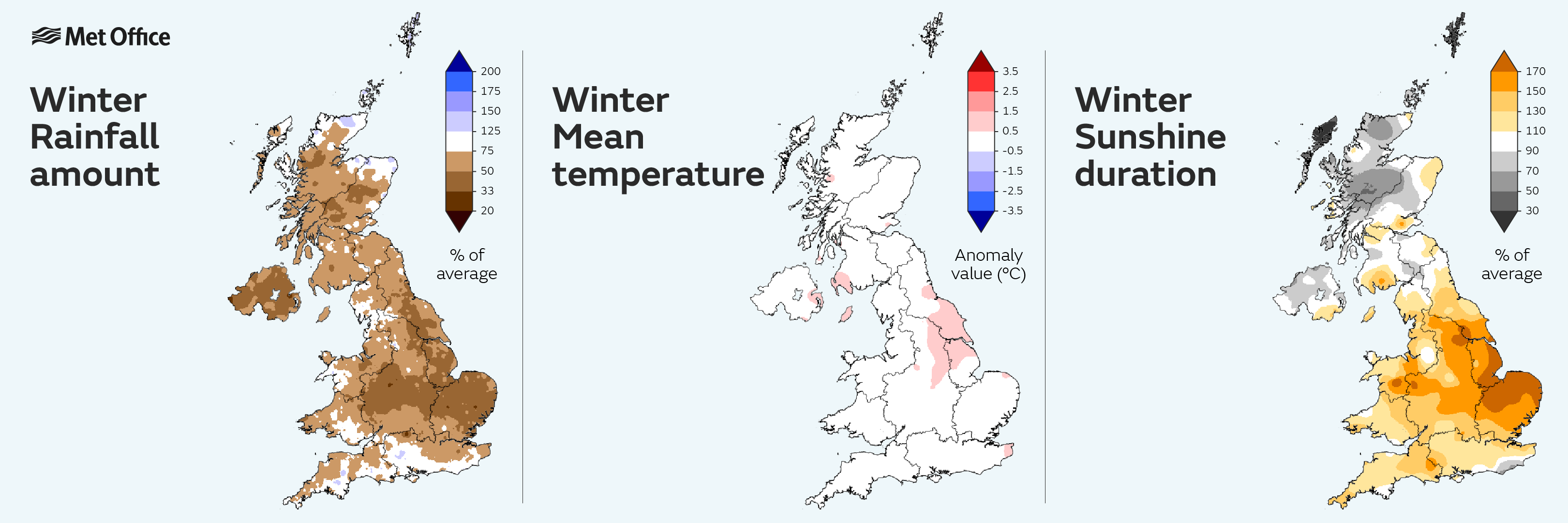
Winter was also slightly milder than average, with an average mean temperature of 4.3°C, which is 0.2°C above average. That’s despite a particularly cold start to December, which saw temperatures drop to -17.3°C at Braemar on 12 December. In contrast, the highest temperature recorded this winter was 17.2°C at Pershore, on 17 February.
Dr Mark McCarthy added: “Winter started with one of the most significant spells of low temperatures to affect the UK since the exceptional December of 2010. After that, however, temperatures have generally bounced back meaning that the season ends as slightly milder than average.
“The one relatively consistent visitor to England and Wales during winter was the sun and many regions saw plenty of winter sunshine, in contrast northern Scotland and Northern Ireland both had a fairly dull winter. It’s a mark of how dry February was that winter’s rainfall figures are 19% lower than the long-term average for the season, as rainfall had been very close to average at the close of January.”
Provisional Winter 2023 statistics
| Maximum temp | Minimum temp | Mean temp | Rainfall | Sunshine | ||||||
|---|---|---|---|---|---|---|---|---|---|---|
| Area | Actual temp (°C) | Anomaly (°c) | Actual temp (°C) | Anomaly (°C) | Actual temp (°C) | Anomaly (°C) | Actual (mm) | Anomaly (%) | Actual (hours) | Anomaly (%) |
| UK | 7.3 | 0.4 | 1.3 | 0.0 | 4.3 | 0.2 | 280.1 | 81 | 182.7 | 113 |
| England | 8.0 | 0.5 | 1.6 | -0.1 | 4.8 | 0.2 | 195.1 | 81 | 223.2 | 121 |
| Wales | 7.7 | 0.3 | 1.7 | -0.1 | 4.7 | 0.1 | 386.2 | 86 | 180.9 | 115 |
| Scotland | 6.0 | 0.3 | 0.5 | 0.2 | 3.3 | 0.2 | 405.1 | 82 | 122.6 | 95 |
|
N. Ireland |
7.7 | 0.2 | 2.2 | 0.4 | 4.9 | 0.3 | 215.6 | 66 | 141.4 | 96 |


